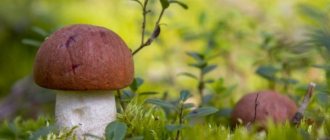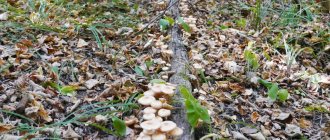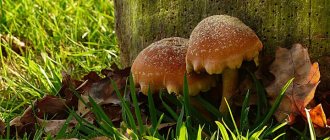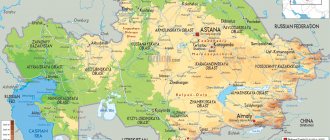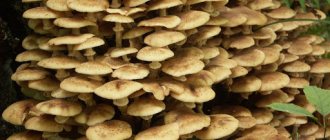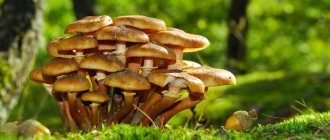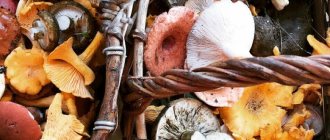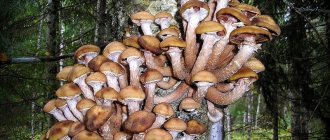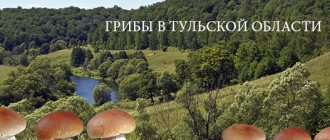Mushrooms
0
1498
Article rating
Kira Stoletova
Belarus is located in the temperate continental climate zone. Summer and spring in the republic are warm and humid. Therefore, mushrooms from the Minsk region are collected from early spring to late autumn. Some “hunters” manage to collect good harvests in winter, under a layer of snow or on tree trunks.
Mushrooms in the Minsk region
Main characteristics
Unusual forest organisms number approximately 100,000 species worldwide. There are about 200 of them growing in Belarus, of which 60 are considered edible. All mushrooms near Minsk have their own category, according to the degree of edibility and taste.
Edibility categories:
- edible;
- conditionally edible;
- inedible;
- poisonous.
The first 2 categories are completely safe for the human body. They are prepared in different ways, and the types that belong to the 1st category (champignons, russula, white mushrooms and mushrooms) are suitable for food without heat treatment.
Conditionally edible and inedible, it is better to pre-soak and rinse several times in running water. All the milky juice will come out with the water and along with it an unpleasant bitterness that can spoil the taste of the finished dish.
WHAT WHAT?
The validity of these words is confirmed by the large supply of mushrooms in the markets. So, at the central market in the regional center, many traders offer to purchase them. However, the prices can hardly be called democratic.
The king of mushrooms - boletus - is in the lead by a wide margin: per kilogram of white mushrooms they ask for 20-25 rubles. Although if you bargain, you can get 15 rubles each.
- And what do you want? – the sellers ask. – The price is dictated by the market. The mushrooms are good, not wormy, collected in Belovezhskaya Pushcha. Small and neat ones cost 25 rubles, and less presentable ones - for drying or frying - can be sold for a tenner. Those who buy in bulk will receive a discount. Thus, a basket of peeled boletus recently sold for 2.5 rubles, and saffron milk caps sold for 8 rubles per kilo.
The price also includes boletus and boletus mushrooms. For a basket of “krasnyuks” they ask for 15 rubles, but after bargaining they agree to pay for 10. There are also chanterelles on the market: on average, a liter jar costs from 2 to 3 rubles. And the cheapest ones are boletus: about 3 rubles per kilogram.
Edible species
Minsk forests are rich in berries, medicinal herbs and mushrooms.
Forest mushrooms come in summer, autumn, winter and spring. But still, the best period for a mass gathering is traditionally considered to be the end of August and the beginning of September for these places.
The most popular in the Minsk region:
- underpads;
- white;
- morels;
- boletus;
- chanterelles;
- boletus.
The first to appear from under the snow are morels and strings - their caps are wrinkled, which makes them sharply different from other species. After the May holidays, they are replaced by raincoats.
In early June, the earth begins to warm up. And wet boletus caps appear from under last year’s rotting leaves. They have a colorful look. Their description cannot fail to attract attention. The brownish, smooth and shiny caps of young individuals proudly flaunt on a dense cylindrical stem. The pulp smells pleasant when cut and has a light beige tint. The fracture will not change its color even after an hour.
Representatives of the Polish mushroom species appear in coniferous forests and mixed forests at the end of June. Outwardly they look a little like white ones. Velvety delicate hats attract attention. The leg is thick and yellow when cut. The aroma is strong and pleasant.
Champignons are universal mushrooms; they are good in any form. They bear fruit from June to October. The white caps stand out clearly under the fallen leaves. Under the outer layer of the cap there is a thin film connected to the stem. In older specimens it bursts and separates from the base. The flesh of these forest beauties has a slightly pink tint.
Belarusians deservedly consider porcini mushrooms to be the most valuable, which appear in July and delight their fans until the end of October. Their aroma and taste are unique: bright and strong, completely balanced. Their flesh does not change its color in any form; even when dry, it remains completely white. For this quality, mushrooms received their name, which over time became generally recognized in science.
Saffron milk caps and chanterelles undoubtedly deserve attention. They look attractive. They taste great.
Irina Selyutina (Biologist):
The fox has its own doubles, but upon closer examination you will notice that the similarity is superficial. First double: false chanterelle . It is characterized by the following points:
- the cap is orange, not yellow;
- the leg is delimited from the cap;
- the edges of the cap are smooth, not wavy;
- the hymenophore is lamellar, not folded;
- the leg is hollow, not solid;
- the flesh is dense, cotton-like (in older ones), and not elastic.
Second double: yellow hedgehog (but only an extremely inattentive person could confuse it with a chanterelle). Here it is enough to look at the hymenophore - in the chanterelle it is folded, and in the hedgehog it is represented by many spines that are easily separated from the lower surface of the cap.
Mushroom places near Minsk contain about 4 species of honey mushrooms. They are summer and autumn, meadow and field. They always grow up in big families. From one place it is easy to collect more than one full basket and feed them to a good company.
DELIVERY TO COOPERATION
However, mushrooms are also accepted from the population at procurement points of the regional consumer union. True, prices for this type of product are lower here than on the market. As a rule, people harvest the first mushrooms for themselves and only then go to cooperators or to the market.
“This year the situation is clearly better than last year, when there were very few mushrooms,” explains Valery Kapitanchik, head of the procurement department of the Brest Regional Consumer Union. – Now people are gradually catching up, procurement is underway in Ivatsevichi, Baranovichi, Pruzhansky, Ivanovo, Kamenets district... Purchasing prices in each of them may differ, but in general we recommend the following. 1st grade porcini mushrooms - 4-8 rubles, 2nd grade - 2-3 rubles, 3rd grade and other mushrooms - up to 1 ruble per kg.
Source of information: Nikolay YARMOSHUK, photo by Valery KOROL - Zarya.
Tags: mushrooms, market 09/15/2017. Views: ———————-
Inedible and poisonous species
Poisonous mushrooms should not be placed in the basket with edible ones.
Poisonous mushrooms:
- death cap;
- gall fungus;
- red fly agaric;
- false chanterelle;
- false honey;
- poisonous rows and talkers;
- satanic mushroom;
- pepper mushroom.
Pale grebe can cause poisoning, even after ordinary touching. Its toxins are strong and penetrate through the skin into the blood, causing bouts of vomiting, diarrhea and fever. All mushrooms that have been in contact with it automatically become poisonous, they must be thrown away without regret - after all, your life and health are at stake.
Irina Selyutina (Biologist):
Pepper mushroom prefers dry coniferous forests and is found from July to late autumn. It can form mycorrhizae with young birch trees. This type of mushroom is often confused with butter mushrooms - it is not for nothing that its synonym is pepper butterfly. It is distinguished from boletus by:
- taste (bitter, pungent);
- color of the hymenophore: red, but in real butterflies it is yellowish;
- leg: absence of film ring.
The literature often states that pepper butter is “inedible due to its pungent peppery taste.” However, many experienced mushroom pickers believe that:
- You can eat it by adding it to a mushroom dish instead of pepper;
- after prolonged cooking, the unpleasant pungent taste disappears.
Toadstools and false honey mushrooms are often confused with common honey mushrooms. Satanic or bilious is mistaken for noble white. But upon careful examination, the satanic one has a fine black mesh on its stem, and the gall one reveals itself with an unpleasant aroma and a burning taste that does not disappear even after soaking.
RADIATION - UNDER CONTROL
Products sold on the market must be tested. Traders bring the mushrooms they plan to sell to the laboratory, where specialists select specimens for radiation control. Recently, there has been an increase in such work at the central market.
“As the mushroom season began, the number of samples increased, sometimes reaching 20-30 per day,” Tamara Kudravets, head of the veterinary and sanitary examination laboratory, explained to ZARYA.BY. – A variety of mushrooms are brought to us: porcini, boletus, boletus, boletus, chanterelle... Mainly from Pruzhansky, Brest regions, Belovezhskaya Pushcha. We test them for radioactive cesium-137. The norm should be 370 becquerels per kilogram. This season, its excess has not yet been recorded. Only in two cases were the highest indicators observed: 276 Bq/kg was shown by mushrooms collected, according to the seller, in the Kobrin region, and 231 Bq/kg from the Kamenets region. However, these figures are within the normal range, and in other samples the figures are low. Therefore, you can safely buy mushrooms in our market.
Hallucinogenic species
Several species of rare hallucinogenic forest organisms grow on the territory of Belarus:
- paneolus moth (moth moth);
- dung beetle;
- fibre, sharp;
- mycena pure;
- the row is smelly;
- Hymonopylus Juno.
They include the so-called. psychoactive substances that cause nervous system disorders. This substance is psilocin, and with its repeated use, a painful condition occurs, leading to personality degradation and schizophrenia.
“The swampy areas provide good conditions for blueberries.”
Photo: Ivan Tkachuk
Due to elevated temperatures and drought, the berry picking period this year began a week earlier than usual. From June 18, it is already allowed to buy blueberries in the Brest and Gomel regions. The Grodno and Mogilev regions will begin collecting on June 23, Minsk - from the 25th, Vitebsk - from the 26th.
“There are good conditions for blueberries in the swampy areas,” says Tatyana Moiseeva. “However, predicting the berry harvest is quite problematic. Now, for example, we are in the Milosevici forestry enterprise in the Gomel region. Today we were in the Dzerzhinsky forestry of the Lelchitsky district. There, closer to the swamps, there are a lot of blueberries, they are large. At the same time, in neighboring forest areas, where the groundwater level is different, there are almost no berries.
For blueberries , scientists have the following forecasts: Brest, Grodno regions - the harvest is below average, Gomel, Mogilev, Minsk - average, Vitebsk - above average.
collect lingonberries in the Brest and Gomel regions from August 6, in Grodno - from the 10th, in Mogilev - from the 12th, in Minsk - from the 15th, in Vitebsk - from the 16th.
“People will go for lingonberries only in August, so if there is a drought, the harvest will be completely reduced,” says Tatyana Moiseeva.
In the meantime, the forecast is as follows: Gomel region - the harvest is low, Brest region - below average, other regions - average.
The cranberry season in the Brest region will open on August 24, in the Gomel region - on the 25th, in the Grodno region - on the 30th, in the Mogilev region - on September 1, in the Minsk region - on the 2nd, in the Vitebsk region - on the 3rd.
The forecast for the harvest is as follows: Minsk, Vitebsk regions - the harvest is average, other regions - below average.
Plans for marsh blueberries: Brest, Grodno, Gomel regions - the harvest is below average, other regions - average.
news.tut.by
Mushroom places in the Brest region
Where to look for mushrooms
A map of the Minsk mushroom area indicates that many edible varieties grow along the highway.
- Vitebsk direction: along the highway, 4 km from Logoisk and to the village of Pleshchenitsy there are good clearings with boletus and boletus.
The villages of Mostishche and Aleshniki (12 km from the city) are excellent places for collecting honey mushrooms.
The Logoisk-Ugly-Shvaby bus runs regularly from the bus station. Having reached the agricultural town of Zembin on it, you can harvest a crop of saffron milk caps and chanterelles from the nearby forest. Near the village itself, along the walking paths, you can come across russula and spring morels.
The Khatyn forest traditionally provides rich harvests of various types of forest organisms for those who like to “hunt” in it. Throughout the season, a huge number of lovers of these delicacies come here.
- Vileyshchyna: to the village. Ilya, located here, is best reached by car. Mushroom spots are located near the Economist recreation center. This area is characterized by an annual good harvest of russula, value and morels.
- village of Stolbtsy: famous for its chanterelles, aspen boletus, autumn honey mushrooms and boletus. It’s better to look for them near the “Vysoky Bereg” tourist base, and it’s more comfortable to get there by car, along the Brest highway, until the turn to the village of Nikolaevshchina. If this is not possible, then you can go by train or bus. Buses regularly go in the Brest direction from the central bus station in Minsk.
- Talkovskoe direction: ideal for hiking; there are a lot of mushrooms here both in summer and autumn. It’s easier to get there by train from the central station and walk through the field to the forest, past the dacha plots, along the river. The interval of such a walk varies from 5 to 20 km. Therefore, good physical preparation will not hurt.
Let's go hunting
“Silent hunting” always arouses genuine interest among amateur and professional mushroom pickers, a desire to “hunt” to their heart’s content. And every year, when the time for “X” comes, hundreds of Minsk residents, armed with baskets, buckets, bags, put on jackets or raincoats, put on shoes, sneakers or boots and set off on a path to collect the harvest.
Professionals have long mapped out treasured mushroom spots, where boletus mushrooms grow under aspen trees, and boletus mycelium is located under birch trees. Amateurs can constantly change their locations, but the fairy of luck still smiles on them. Moreover, if it rained the day before, and the mushrooms became apparently invisible. Therefore, no matter what happens, they do not go home empty-handed.
What mushrooms can be collected in May and early June?
The next mushroom hunting season in the republic falls at the end of May - beginning of June. At this time, the rowan blossoms and the rye begins to spike. There are few mushrooms at this time, but you can find them.
At the beginning of summer, mushrooms in Belarus grow in the lightest places in the forest: edges, clearings, and in young forests where dense vegetation has not yet formed. There is no need to expect a bountiful harvest at this time, since there is not enough heat yet, although there is plenty of moisture in the ground. Mushrooms at the beginning of summer are usually called “scouts”: they crawl out of the ground to check whether it is warm in the forest and whether it is already possible to grow en masse. This time of mushroom growth is short, it lasts about two weeks. What types of mushrooms are relevant in Belarus at this time? Butterflies, russula, fly mushrooms, and porcini mushrooms can also be found.
